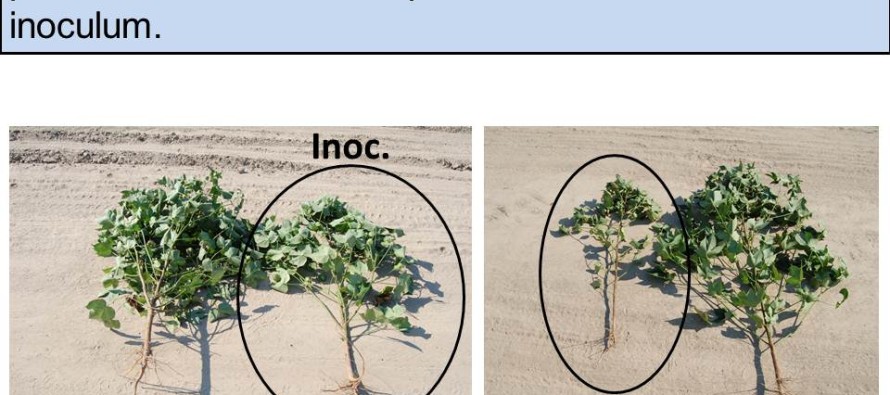Response of Cotton Varieties to Inoculation with Xanthomonas axonopodis pv. malvacearum in Mississippi

Introduction
Bacterial blight (angular leaf spot) of cotton, caused by Xanthomonas axonopodis pv. malvacearum (Xam), has historically been a devastating foliar disease. The disease has been reported to occur in most cotton producing areas throughout the world (Bird 1986; Verma 1986) and is the primary reason for widespread adoption of acid-delinted seed. In general, Xam can cause a seedling blight, leaf spot, lesions on stems, petioles, and bolls, as well as a boll rot (see Fig. 2A-D). Symptoms of bacterial blight on leaves first appear as water-soaked spots that develop into angular-shaped lesions delimited by veins. In severe cases, bacterial blight infection in susceptible varieties results in defoliation and a reduction in plant height. During elongated periods of environmentally conducive conditions, large yield reductions in addition to poor fiber quality can be observed. Depending upon the level and timing of infection and prevailing environmental conditions, secondary spread of the pathogen can occur either naturally or mechanically.
In 2011, a bacterial blight epidemic was identified in several fields in western MS and in a single isolated field in eastern MS. Many of the fields with excessive infection had not recently been in cotton production and one of the fields (eastern MS) had never produced cotton. Numerous methods of secondary spread of the bacterium can occur throughout a typical season. However, based on the available literature, the primary source of the bacterium is from infested seed. Moreover, the majority of the commercially available varieties present in MS are susceptible to the bacterium.
Bacterial blight inoculation trials of commercially available varieties have been conducted in the field for the past five years in Stoneville, MS. However, in an attempt to further our knowledge regarding the pathosystem, yield and cotton quality variables in addition to field-level disease ratings were considered important. The main objective of the project was to determine the reaction of 22 commercially available cotton varieties to bacterial blight inoculation in field challenge trials.
Materials and Methods
Cotton was planted using a split-plot design. Whole plots were defined by inoculation strategy (inoculated vs. non-inoclulated). Sub plots consisted of varieties arranged in a randomized complete block with four replications. Sub-plots consisted of two 40†rows of cotton approximately 40’ long. Four isolates of race 18 were cultured on Potato Carrot Dextrose Agar media and maintained by transferring to new media every 10 to 14 days. Inoculum was prepared by mixing bacteria with water at a concentration of approximately 5.0 × 105 viable cells per milliliter and included 1.25% of a silicon-based adjuvant applied as Dyne-Amic (Helena, Inc.). The inoculum was applied to the abaxial side of leaves using a tractor mounted sprayer at 150 PSI pressure to force the inoculum through the leaf stomata. The inoculation occurred at first white flower. Fourteen days post-inoculation, plots were visually examined for disease symptoms. Rating was based on a 0 to 9 scale where 0 was indicative of no disease symptoms or defoliation, 1 = presence of disease symptoms on leaves, 2 = infected plant material present in the lower canopy, 5 = infected plant material present in the mid to upper-canopy along with some defoliation, and 9 = total defoliation of the plant. Lint yields were determined by mechanical harvest and hand-picked boll samples. Fiber quality parameters were evaluated at Starlab, Inc.
Results
–Foliar rating observed 14 d after inoculation suggested approximately 5 of the 22 varieties expressed some form of tolerance to Xam. Specifically, DP 1133 B2RF, FM 1740B2F, FM 9058F, PHY 375 WRF, and ST 5288B2RF conferred tolerance (Fig 3A).
–Seed index was significantly influenced by the inoc × variety interaction. In general, averaged over varieties seeds from inoculated plants weighed 0.6 g less than seed from non-inoculated plots (Fig. 3B).
–Plant height (Fig. 1) was significantly influenced by the main effect of inoculation and variety. Averaged across inoculated varieties, final plant height was reduced approximately 23% when compared with non-inoculated varieties (Fig. 4A).
-Individual boll weight was marginally influenced by inoculation, with a 9.3% reduction observed between inoculated and non-inoculated plots (Fig. 4B).
–Averaged across varieties, plots receiving inoculation with Xam yielded approximately 26% less lint than non-inoculated plots resulting in a 214 lb lint/acre lint yield decrease (Fig. 4C).
–Fiber micronaire was also influenced by the main effect of inoculation. Micronaire was reduced by 0.19 or 4% when comparing inoculated vs. non-inoculated varieties, respectively (Fig. 4D).
References
–Bird, L.S. 1986. Half a century dynamics and control of cotton disease: Bacterial Blight. Proc. Beltwide Cotton Prod. Res. Conf., Cotton Disease Council 46:41-48.
–Salaheddin, K., Valluvaparidasan, V., Ladhalakshmi, D., and Valazhahan, R. 2010.0Managmenet of bacterial blight of cotton using a mixture of Pseudomonas fluorescens and Bacillus subtilis. Plant Protect. Sci. 46:41-50.
–Verma, J. P. 1986. Bacterial Blight of Cotton, CRC press, Inc.









Let me tell You a sad story ! There are no comments yet, but You can be first one to comment this article.
Write a comment